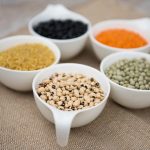Let’s take a brief look back at our food supply over the past few years, shall we? At the start of the twentieth century, corn and soybeans had become the most widely cultivated plants in the United States. Farmers saw that when government subsidies made their crops the least expensive to produce, the ag industry could gain advantage.
Corn and soybeans were not only used for food but used in paint and plastic products. Around the 1960’s corn and soy were being replaced by petroleum products in the paint and plastic industries, so corn and soybean farmers pivoted to the food market. The oils from corn and soybeans were marketed as healthier due to the fact that they were unsaturated fats.
Genius, right?!
The culmination of the shift towards using polyunsaturated fats in place of saturated fats occurred with the introduction of the lipid hypothesis, which was based on arguments that Heart Disease was caused by saturated fat and cholesterol. The PUFA consumption has increased ever since.
Even now, saturated fat continues to be looked upon unfavorably, while practitioners of conventional medicine suggest increasing the amount of unsaturated fats, especially polyunsaturated fatty acids (PUFA), one consumes.
The Controversy
There are opposing positions for almost every medical conclusion.
In 2017, the American Heart Association Presidential Advisory strongly endorsed that “lowering intake of saturated fat and replacing it with unsaturated fats, especially polyunsaturated fats, will lower the incidence of CVD” (Cardio Vascular Disease).
Three months later, the 18-country observational Prospective Rural Urban Epidemiology (PURE) Study concluded much the opposite: High carbohydrate intake was associated with higher risk of total mortality, whereas total fat and individual types of fat were related to lower total mortality. Total fat and types of fat were not associated with cardiovascular disease, myocardial infarction, or cardiovascular disease mortality, whereas saturated fat had an inverse association with stroke.
Harvard Health disagrees with the PURE findings:
PURE researchers collected self-reported dietary data from 135,335 people in 18 countries, and grouped them according to the amount of carbohydrate, fat, and protein they consumed. After tracking participants’ health over a seven year period, researchers found that those with the highest intake of dietary fat (35% of daily calories) were 23% less likely to have died than those with the lowest intake of fat (10% of daily calories). Oppositely, for carbohydrates, those with the highest intake (77% of daily calories) were 28% more likely to have died than those with the lowest intake (46% of daily calories). From these findings the authors’ main conclusion is that “high carbohydrate intake was associated with higher risk of total mortality, whereas total fat and individual types of fat were related to lower total mortality.”
The Problem
There is still SO much to understand about our complicated body and how things work. We can run mathematical algorithms to interpret data but there are unknowns that we don’t even know to look for. When we try and understand nutrients and how they affect disease, we focus on one nutrient at a time. However, that is not how we eat or how our bodies work. Nutrients are rarely ingested in isolation.
- Nutrients are not eaten in isolation.
- Processing and preparing foods changes nutrient density and quality.
- Trial participants all have their own unique genetic makeup and your genetic makeup does impact your health.
- Studies are generally small in population compared to the world’s population.
- Studies generally have a short duration.
- We still lack knowledge.
What are PUFA’s?
PUFA stands for Poly-Unsaturated Fatty Acid. The chemical makeup of the fatty acid includes multiple (poly) double bonds in the carbon sequence. These fatty acids are not filled up with hydrogen atoms, unlike its saturated counterparts which possess them. The bonds are not completely finished in a certain way. Imagine a chain made up of links that lacks a couple of connecting pieces on each link; it would not be secure or steady. Due to the lack of stability, polyunsaturated fatty acids are particularly vulnerable to oxidation, which disrupts the chain and harms its efficacy in the body.
Omega-3 and Omega-6
There are two classes of polyunsaturated fatty acids (PUFAs): omega-3 and omega 6. Omega-3 essential fatty acids can be obtained from fatty fish, such as shellfish and liver, and from certain types of seeds, such as flax. They’re good for us in moderate amounts.
Omega-6 polyunsaturated fatty acids (PUFAs) are far and away the most common. Omega-6 polyunsaturated fatty acids can be found in modest amounts in sources such as seeds, nuts, legumes and products derived from animals that were raised using proper practices. Instead of keeping animals in clean and healthy environments, nowadays they are usually surrounded by pools of fecal matter, which are filled with the same rubbish food that humans eat regularly – a diet heavy in polyunsaturated fatty acids that causes the animals to become unwell due to an inability to process it properly.
One of the primary issues with omega-6 is that our bodies are not designed to digest large amounts of it. Our fat cells contain hardly any omega-6 polyunsaturated fat, and are formed mostly of saturated and monounsaturated fat. When we consume the oils from these foods in a more concentrated form than what is habitually eaten, an imbalance is caused and can result in some serious health issues.
Let me put it this way. When was the last occasion you enjoyed a large helping of cottonseeds? What’s that?? Never!? Thanks to the advances made in the food processing industry, cottonseed oil is frequently eaten, likely in large amounts, together with soybean oil, canola (rapeseed) oil, corn oil, safflower seed oil, and sunflower seed oil- all of these being concentrated sources of polyunsaturated fatty acids.
The Study
Background
Increased amounts of n-3 polyunsaturated fats (PUFA) in the blood have been tied to a reduced probability of mental deterioration with age, and positively influence factors that affect heart and metabolic health. There is a correlation between metabolic ailments including diabetes type 2 and a decrease in cognitive ability. The outcomes of potential impacts of n-3 PUFAs on risk factors in healthy individuals are variable, and there is little evidence regarding how cardiometabolic factors may be related to cognitive functioning. The goal was to measure the consequences of consuming long-chain n-3 PUFA for five weeks on cognitive function in healthy people, and to find out whether outcomes in cognitive assessments can be correlated to cardiometabolic risk factors.
Methods
Subjects consumed 3g of fish oil n-3 PUFA for five weeks, followed by a five week break where a placebo was used, in an experiment that included forty healthy individuals from middle age to elderly. The effectiveness of thinking was calculated through examinations gauging working memory and selective attention.
Results
The use of n-3 PUFA was shown to lead to higher scores in the WM-test when compared to the control group, which was statistically significant (p < 0.05). Compared to the placebo, n-3 PUFA decreased plasma triacylglycerides significantly (P < 0.05) and systolic blood pressure drastically (p < 0.0001). A significant decrease in systolic blood pressure (p < 0.05), f-glucose (p = 0.05), and s-TNF-α (p = 0.05) was correlated with poor performance on cognitive tests.
Conclusions
Consumption of n-3 PUFA improved healthy individuals’ cognitive functioning after a five-week period when compared to the placebo group. Additionally, a link between cardiometabolic risk factors and cognitive performance in the opposite direction was established meaning that dietary prevention strategies should be employed to postpone the emergence of metabolic illnesses and cognitive deterioration that go alongside it.
Background
N-3 polyunsaturated fatty acids (PUFA) with long-chain structure, namely docosahexaenoic acid (DHA) and eicosapentaenoic acid (EPA), are crucial for proper brain performance and psychological well-being. It has been shown in studies involving individuals of middle age and older that a greater proportion of n-3 PUFA in blood has been associated with a decreased chance of cognitive decline. Numerous investigations demonstrate that people who eat a high amount of fish experienced less deterioration and better mental acuity. Although there have been some trials to find out how n-3 PUFA affects cognitive functions in healthy people, there hasn’t been a lot of research done, and the results from these studies are inconsistent. A randomized controlled study of 302 people over the age of 65, where neither the participants nor the research team knew which participants were receiving EPA+DHA (omega-3 fatty acids) or a placebo, found no differences in attention, speed, or memory and decision-making skills after 26 weeks of supplementation with either 1800 mg or 400 mg per day of EPA+DHA. A trial with 458 healthy participants showed improved visuospatial learning and episodic memory after consuming 900 mg of DHA for 24 weeks. The trial was randomized and double-blinded with a placebo control group. In a research project that focused on a limited number of individuals, 33 persons were given a daily intake of 1.6 g of eicosapentaenoic acid (EPA) and 0.8 g of docosahexaenoic acid (DHA) from fish oil for a period of 35 days, whereas the other 16 people took olive oil as a placebo. Adding n-3 PUFA to one’s diet was linked to an enhancement in concentration skills and emotional wellbeing. In a different study that employed a randomized double-blind approach, fifty-four healthy young adults were provided either a 2.3 gram supplementation of n-3 PUFA (1.74 grams of EPA and 0.25 grams of DHA) or a placebo of olive oil daily for a period of four weeks. PUFA supplementation was associated with performing fewer risk-averse decisions.
Cardiometabolic conditions like metabolic syndrome, impaired sugar uptake, and diabetes can lead to a reduced capacity for cognitive endeavors, including decreased memory and managerial aptitudes, inclination to process data quickly, focus, and general intellectual performance. Studies have revealed positive effects of long-chain n-3 PUFA treatments on a number of important factors related to metabolic health, such as decreased blood pressure and triglyceride levels, decreased inflammatory indicators, as well as enhanced glucose metabolism and insulin sensitivity.
Subjects and Methods
Study population
From the south of Sweden, 31 individuals (split between 30 women and 14 men) aged 51–72 (mean age being 63 ± 5 years) with a BMI ranging between 20–30 kg/m2 (mean BMI of 25 ± 3) were acquired for the study through local newspaper advertisements. Criteria for being excluded included having a blood glucose level of more than 6.1 mmol/L, a BMI higher than 30 kg/m2 and either a pre-existing metabolic ailment, gastrointestinal issue or documented mental decline. The participants in the study were permitted to use medication for hypertension, however, its usage had to remain unchanged throughout the experimentation. The participants needed to be able to speak Swedish fluently. The only person out of the group who wasn’t a native Swedish speaker was born in the United Kingdom but was able to fluently speak the Swedish language.
Recruitment began October 2008. Trials took place between January 2009 and June 2009. Of the 44 people who signed up for the experiment, 4 discontinued after the initial intervention portion (2 while using placebos and 2 while using omega-3). The 3 who left were due to personal causes, while a fourth was disqualified because they had a health issue that caused interrupted wakefulness. A total of 40 people took part in the intervention, but two had to be excluded as their fasting blood sugar was abnormal (values of 7.0 and 6.7 mmol/L). Altogether, data was collected from 38 individuals who had finished the study, consisting of 28 women and 10 men, who ranged in age between 51–72 years old (average: 63.3 ± 5.3) and had a BMI between 20–31 kg/m2 (average: 25.0 ± 2.8). 20 of the 38 participants began with a n-3 PUFA supplement, while 18 began with a placebo. Twenty-two subjects were senior citizens. One of the participants occasionally smoked, but refrained from smoking the day before and during the time of the experiment. Before the study began, the individuals involved were questioned about their diets and overall well-being. At each visit, before and after the intervention phase, a questionnaire was completed regarding diet, physical activity, health, and medicine usage. All participants ate a standard Swedish diet that included both meat and fish each week. The participants were instructed to keep eating their usual meals throughout the experiment. When analyzing food diaries for every participant, it can be reported that there were not any enormous variations in diet or exercise throughout the full duration of the examination. No physical examination was included. It was uncovered through interviews and records that seven individuals were taking prescriptions for hypertonia, as well as one person on Simvastatin to decrease their cholesterol levels. A person was taking medication to treat their depression for a minimum of twelve months without any measurable improvements in symptoms. There were three individuals who had mild osteoarthritis, one of whom was prescribed glucosamine. An assessment of the starting data post-intervention showed that five participants had relatively large amounts of triacylglycerides (2.3, 2.3, 2.7, 2.8, and 3.3 mmol/L), and three other individuals had amounts near the cut-off (1.8, 2.0 and 2.2 mmol/L).
No significant adverse reactions or issues related to taking the supplements were noted.
Why is Polyunsaturated Fat So Bad?
Using an online search engine, if you look up “polyunsaturated fat,” you will quickly come across mainstream medical websites promoting it as a superior option than saturated fat, which most of us are encouraged to avoid. However, those of us that have been taught from sources which aren’t gaining financially from the food and medical areas are aware that this is an utter falsehood. They are onto something, though. Not all fats are healthy. So what makes polyunsaturated fat so inferior to saturated? There’s more to it than you might think.
READ MORE: The Good Truth About Saturated Fat
DNA-Disrupting Inflammation and Free Radical Damage
The major issue associated with consuming PUFA oils in large quantities is the inflammation it can cause in the body. Lots of foods are somewhat inflammatory. And, that’s okay. A little bit of inflammation helps your immune system function efficiently. When inflammation is too intense, it can be no longer advantageous. Evidence suggests that increased levels of inflammation can result in dangerous ailments such as heart disease, diabetes, and cancer.
Too much inflammation in the body from PUFAs occurs due to the presence of free radicals produced in the manufacturing of industrial oils (like vegetable and canola), which makes them go bad. Atoms that have an unbalanced electron moving around are known as free radicals. This results in them becoming exceptionally unstable. The elements within these compounds can demolish cell walls and red blood cells, as well as harming DNA and RNA molecules, ensuing in genetic variations in the body’s tissues. In skin, it causes wrinkles and premature aging. In blood vessels, the buildup of plaque. It can be a precursor to the development of tumors in tissues and organs. I think you get the picture. Free radicals can be highly detrimental and they are commonly found in industrial polyunsaturated fatty acids oils.
PUFA and Your Metabolism
PUFA oils wreak havoc on the body’s metabolism. Polyunsaturated fatty acids have an effect on the thyroid gland and its capacity to process thyroid hormones in the body. This is a major factor behind a slow metabolism in the body, when the functioning of the thyroid is disturbed.
Do not forget about the aggravation of inflammation that is typically associated with PUFAs. This leads to a surge in cortisol, a hormone correlated to increased amounts of belly fat, as well as an unusual thing known as SOCS-3. This is due to hormones which activate upon observing molecules such as Interleukin-6, which, although it appears to be the moniker of a science fiction protagonist, is actually an inflammatory agent that increases parallel to the amount of omega-6 PUFAs in people’s diets. The secretion of stress hormones is a significant event. The stress hormone slows your metabolism and making it store fat even after the body has stored enough.









